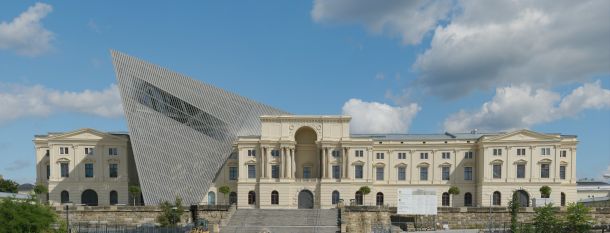There’s plenty of elegant classical architecture to see on a river cruise – but what about the world’s weird and wonderful modern buildings?
Military Museum, Dresden (pictured above)
First on the list is the incredible stabbing spike that juts viciously out of Dresden’s palatial military museum. Almost seventy years ago the Military Museum came close to complete destruction during the Second World War, but was faithfully rebuilt in the years to follow.
The building was given its radical and controversial steel-and-glass shrapnel addition by American architect Daniel Libeskind in 2011, the man behind the hulking, fragmented form of the Jewish Museum in Berlin. Dresden’s new shard has divided opinion ever since it was completed, standing as a jarring visual statement of Germany’s military history and the violent horrors of war.
 Dancing House, Prague
Dancing House, Prague
This fantastical form is known more formally as the Nationale-Nederlanden Building, belonging to one of Europe’s biggest insurance companies, ING. Prague’s twisting landmark was the result of a joint effort between Czech architect Vlado Milunic and Frank Gehry – the man behind the Guggenheim Museum in Bilbao.
The building was designed as a stand-out modern landmark for central Prague, and it certainly grabbed plenty of attention – and controversy – when it was completed in 1996. The Dancing House stands in complete discord with the orderly period buildings around it; a writhing glass tower that presses into the undulating office block beside it. Both parts jump out into the street; a sudden bolt of fragmentation in the stoic heart of classical Prague.
 Neumarkt-Galerie, Cologne
Neumarkt-Galerie, Cologne
Some architecture, on the other hand, doesn’t need to make a brash deconstructivist statement to stand out. Sometimes it’s just nice to see a building with a gigantic ice cream dropped on top of it. The ten-metre Dropped Cone artwork was designed and produced in 2001 by two American artists, Coosje van Bruggen and Claes Oldenburg.
It was commissioned by the Neumarkt-Galerie, one of Cologne’s biggest shopping centres, to attract the attention of the shoppers in the city’s buy high street. Given free reign to place an installation anywhere around the shopping centre, the artists decided to mount their piece on the corner of the roof and create a new landmark. Its design was inspired by a desire to stand out against the classical towers of the iconic cathedral – and, so the artists say, simply because ‘Cologne’ includes the letters that spell out ‘cone’.
 China Central Television Headquarters, Beijing
China Central Television Headquarters, Beijing
Among Beijing’s crowded skyline is the incredible shape of CCTV’s headquarters; an enormous looping landmark that seems to defy gravity in the space it occupies. The building was designed by China’s Office for Metropolitan Architecture and completed in 2012 – and at almost 800ft in height, it’s difficult to miss on a journey into central Beijing.
The headquarters of China’s state television was originally built in three separate towers, and later linked together with the construction of its horizontal forms. The building certainly makes its mark on the skyline with its radical new shape; and inside the clean, solid lines of its puzzling exterior lies a complex warren of studios, administrative offices and production centres. The locals don’t always refer to it as the CCTV Headquarters, though… apparently a local taxi driver was responsible for its new name, ‘Big Pants’.
 Cubic Houses, Rotterdam
Cubic Houses, Rotterdam
Dutch architect Piet Blom designed Rotterdam’s colourful modern housing to represent the shapes of abstract trees – but also as a way of creating roomy accommodation in the city centre, with plenty of public space directly beneath the houses’ ‘trunks’.
Inside the housing complex is a bright public square, a self-contained neighbourhood that’s framed by the clustered forms of the bright yellow homes. This is structuralist design at its best – a practical reaction to the dour, rationalist post-war urban planning of earlier decades. In architecture like the Cubic Houses we can see an exciting reaction to the design that came before it; created with the needs and identity of its residents in mind.
There’s a huge amount of classical and modern architecture to see on river cruises. Many itineraries include tours of urban centres, so there’s plenty of opportunity to see some of these strange landmarks up close.
You can speak to our award-winning Cruise Concierge team on 0800 197 0854 if you’d like to make a booking, or even if you’d just like some advice on the river cruise experience. Alternatively, let us know your thoughts in the comments section below!
Images courtesy of Kolossus, Wikimedia Commons; Dino Quinzani, Wikimedia Commons/Flickr; Superbass, Wikimedia Commons; IamDavidtheKing, Wikimedia Commons; Alberto Garcia, Flickr.



